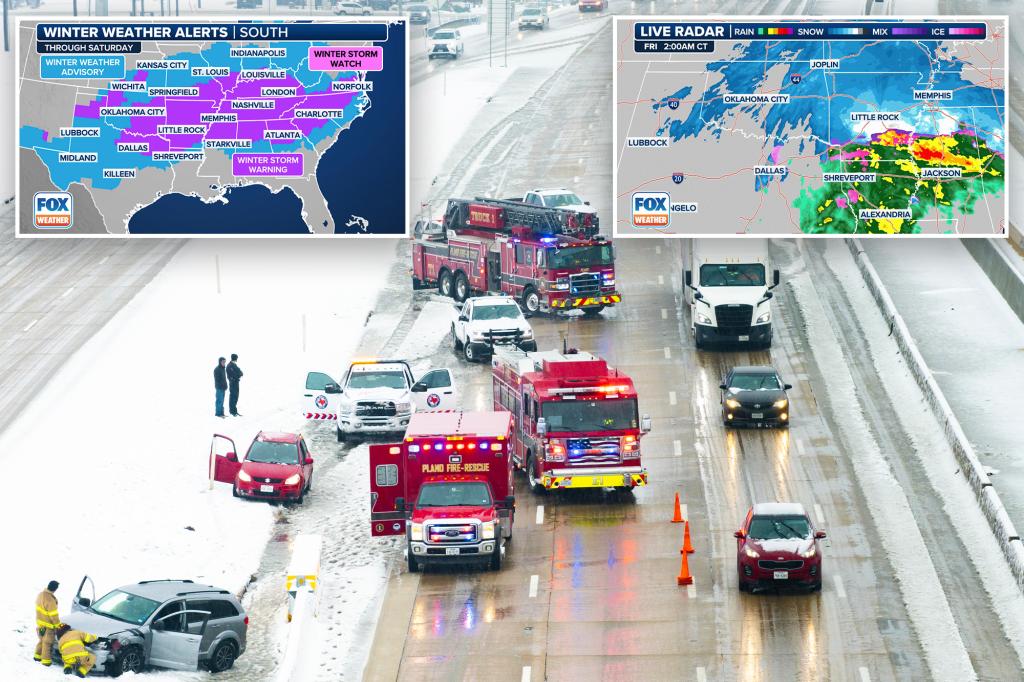A potent winter storm, originating in Texas and Oklahoma, swept across the southern United States, leaving a trail of heavy snow, treacherous ice, and widespread disruption. Millions of children from Texas to South Carolina and as far east as Georgia were granted a reprieve from school as districts closed their doors in anticipation of hazardous conditions. Governors across impacted states declared states of emergency, mobilizing resources to address the storm’s impact. Arkansas Governor Sarah Sanders activated the National Guard to assist stranded motorists, highlighting the severity of the weather event. The storm’s trajectory brought significant snowfall, with predictions of 6 to 9 inches accumulating in parts of Arkansas and Tennessee. Further south, a dangerous mix of sleet and freezing rain coated roads in Louisiana, Mississippi, and Alabama, creating perilous travel conditions.
The storm’s initial impact on Texas and Oklahoma was substantial, with some areas reporting up to 7 inches of snow. This heavy snowfall, combined with freezing temperatures, led to widespread travel disruptions. Over 4,500 flights were delayed, and an additional 2,000 were cancelled as airports struggled to cope with the adverse weather. Roadways became equally treacherous, with reports of vehicles sliding and becoming stuck. Truck drivers, like Charles Daniel, who navigated the slushy roads of central Oklahoma, cautioned against unnecessary travel, emphasizing the dangerous conditions. The combination of snow and ice created a challenging situation for both commuters and commercial drivers.
The storm’s eastward movement brought a swath of snow and ice, impacting a wide region encompassing Mississippi, Georgia, Tennessee, Kentucky, North Carolina, and South Carolina. Meteorologists warned of the impending hazardous conditions and urged residents to take precautions. Texas Governor Greg Abbott advised residents to avoid driving if possible, acknowledging the dangerous road conditions. This warning was particularly pertinent given the anticipated influx of 75,000 fans expected at AT&T Stadium in Arlington for the Cotton Bowl college football playoff semifinal.
The storm’s continued eastward progression brought heavy snow and freezing rain to areas as far north as the coasts of Virginia and North Carolina. Forecasters predicted significant snowfall accumulations, with up to 8 inches possible in parts of Georgia, North Carolina, Tennessee, and West Virginia. Georgia Governor Brian Kemp declared a state of emergency, recognizing the potential for widespread disruption. The Atlanta metropolitan area braced for significant snow and ice accumulation, leading to school closures for over a million students. The potential for treacherous roadways and power outages underscored the severity of the impending weather.
The widespread impact of the storm prompted school closures across multiple states. In Tennessee, Memphis-Shelby County Schools, the state’s largest district, cancelled classes, impacting over 100,000 students. With heavy snowfall predicted for Memphis, warming centers were opened to provide shelter from the frigid temperatures. South Carolina, bracing for its first significant winter weather in three years, initiated preemptive measures. The state’s Department of Transportation deployed crews to treat major highways with brine and salt in anticipation of snow and ice. School districts in affected areas announced closures or transitions to online learning.
North Carolina Governor Josh Stein declared a state of emergency as the state prepared for snow, sleet, and freezing rain. The impending storm even led to the cancellation of the outdoor inauguration ceremony for Governor Stein and other state officials. The far-reaching impact of the winter storm extended beyond snow and ice. In Richmond, Virginia, a boil-water advisory was issued following a storm-related power outage that impacted the city’s water reservoir system. City officials established water distribution sites to provide bottled water to residents, with special provisions made for older residents and those with limited mobility. The cumulative effect of the winter storm, spanning multiple states, demonstrated the significant disruptive power of such weather events, impacting transportation, education, and essential services.

